天王星 月惑星研究会 関西支部

Uranus Image 2006/08/07(UT)
Robert Heffner,Ralf Vandebergh,Marc Delcroix
R.Heffner,R.Vandebergh,M.Delcroix
|
Robert Heffner (280mm SCT) |
Here is another observation of Uranus and its satellites. I believe the
image may show polar brightening i(?) n the Northern polar region of the
planet,similar to my image from 7/29.
This time long exposure mode was used with the LU075C,14.3 secs
maximum gain,gamma of 2.1. 20 frames were stacked,and Layer 4 of the
Dyadic wavelets in RegiStax3 was used to process the satellites. I was
able to image 4 of the satellites this time. Next time I will try for a
better positioning of Miranda when it is further away from the planet so
as not to lose it in the overexposure.
Seeing was fair for the Uranus image.
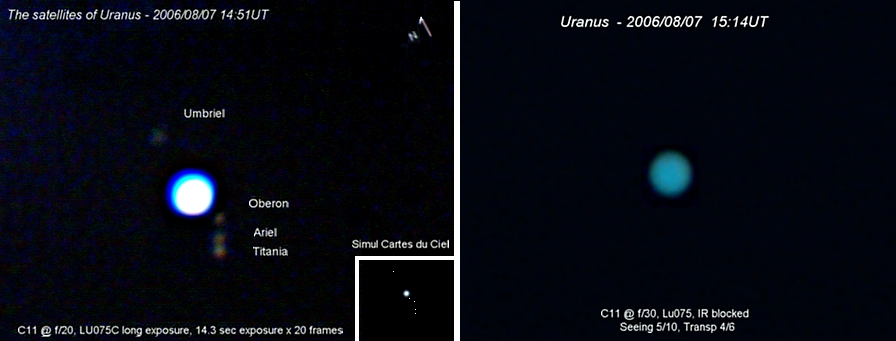 [Robert Heffner:Aichi,Japan]
[Robert Heffner:Aichi,Japan]
|
Ralf Vandebergh(250mm Newton) |
I observed Uranus on Aug 7.Images were taken using luminance,and through red and blue filters.
This is my first session
on the remote planet since October 2004.
After processing of the first images,again some exitement came up,as there was clearly an albedo feature visible in the
lum image,it manifests itself as a darkening on one site of the planet.This was not new for me,as I captured a compareable
feature several times in 2004.The lum image from 01:42 UTC shows this darkening,as a kind of dark cap on one side of Uranus.
Most important is that the control-image,taken 4 minutes later: 02:46 UTC shows the same feature.So this must be real.
Added is also a high contrast version of this capture.
On another interesting note is the appearance of the red images.Here is some albedo structure visible too,but we see
totally other features.As the negative image illustrates best,the main feature on the red image is a brightening left on the
disk.This must be the brightening of the south pole of Uranus,as this should be the most striking detail in red or IR images.
As expected,the blue image(here taken unfortunately partially through the clouds,so not optimal circumstances)shows
nearly no detail.A green image could not be taken,due to upcomming clouds,so the color result is RsGB.
All images: 10 inch Newtonian & ATK-1HS camera)
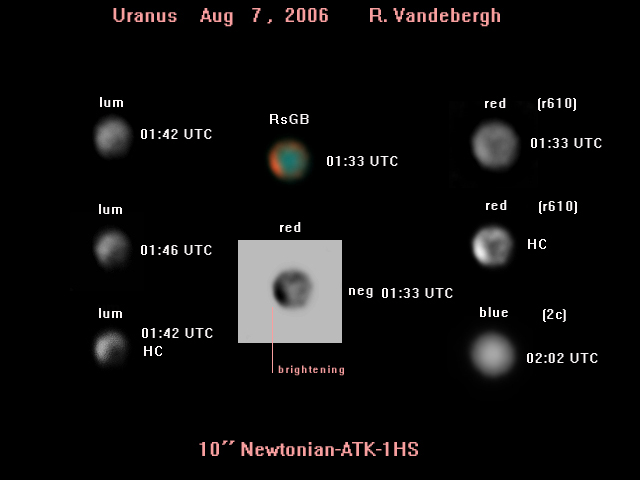
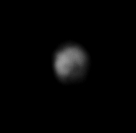 Here are 2 other versions from my Aug 7 image of Uranus
Especially limb darkening is obviously seen here.
left: normal contrast,right:same filters but high contrast.
Here are 2 other versions from my Aug 7 image of Uranus
Especially limb darkening is obviously seen here.
left: normal contrast,right:same filters but high contrast.
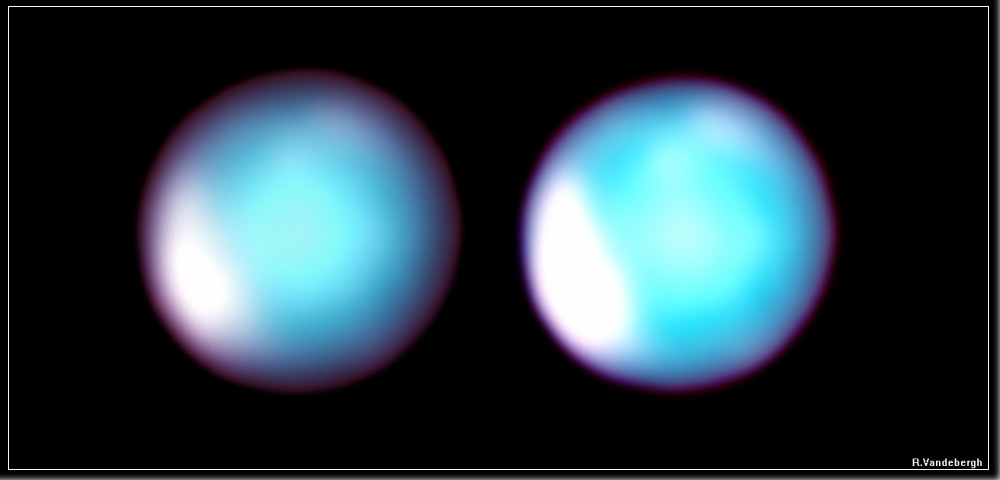 I observed Uranus on Aug 7.Images were taken using luminance,and through red and blue filters.This is my first session
on the remote planet since October 2004.
After processing of the first images,again some exitement came up,as there was clearly an albedo feature visible in the
lum image,it manifests itself as a darkening on one site of the planet.This was not new for me,as I captured a compareable
feature several times in 2004.The lum image from 01:42 UTC shows this darkening,as a kind of dark cap on one side of Uranus.
Most important is that the control-image,taken 4 minutes later: 02:46 UTC shows the same feature.So this must be real.
Added is also a high contrast version of this capture.
On another interesting note is the appearance of the red images.Here is some albedo structure visible too,but we see
totally other features.As the negative image illustrates best,the main feature on the red image is a brightening left on the
disk.This must be the brightening of the south pole of Uranus,as this should be the most striking detail in red or IR images.
As expected,the blue image(here taken unfortunately partially through the clouds,so not optimal circumstances)shows
nearly no detail.A green image could not be taken,due to upcomming clouds,so the color result is RsGB.
Here are the final processings of my Aug 7,Uranus session.
The natural color version is composed of the data from the red
image(with the
brightening of the SPR)and the blue image.
The High contrast bw version shows some other albedo variations too.
Both images show the bright SPR,on the left side of the disk as the
most striking albedo feature of Uranus.
I observed Uranus on Aug 7.Images were taken using luminance,and through red and blue filters.This is my first session
on the remote planet since October 2004.
After processing of the first images,again some exitement came up,as there was clearly an albedo feature visible in the
lum image,it manifests itself as a darkening on one site of the planet.This was not new for me,as I captured a compareable
feature several times in 2004.The lum image from 01:42 UTC shows this darkening,as a kind of dark cap on one side of Uranus.
Most important is that the control-image,taken 4 minutes later: 02:46 UTC shows the same feature.So this must be real.
Added is also a high contrast version of this capture.
On another interesting note is the appearance of the red images.Here is some albedo structure visible too,but we see
totally other features.As the negative image illustrates best,the main feature on the red image is a brightening left on the
disk.This must be the brightening of the south pole of Uranus,as this should be the most striking detail in red or IR images.
As expected,the blue image(here taken unfortunately partially through the clouds,so not optimal circumstances)shows
nearly no detail.A green image could not be taken,due to upcomming clouds,so the color result is RsGB.
Here are the final processings of my Aug 7,Uranus session.
The natural color version is composed of the data from the red
image(with the
brightening of the SPR)and the blue image.
The High contrast bw version shows some other albedo variations too.
Both images show the bright SPR,on the left side of the disk as the
most striking albedo feature of Uranus.
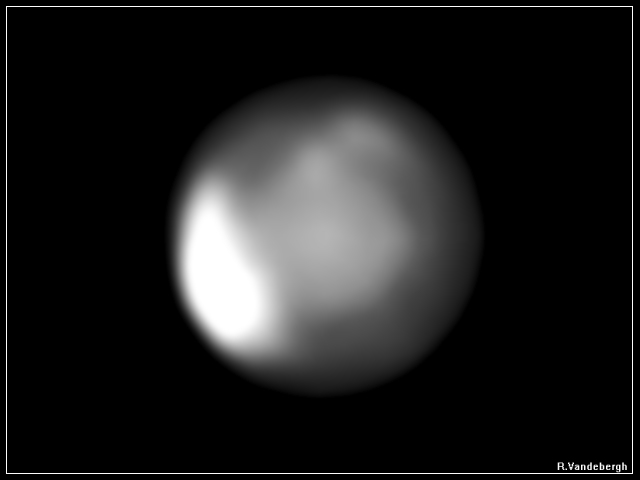
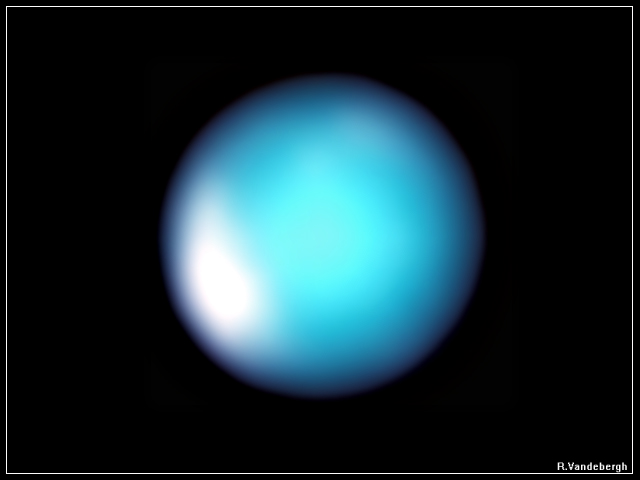

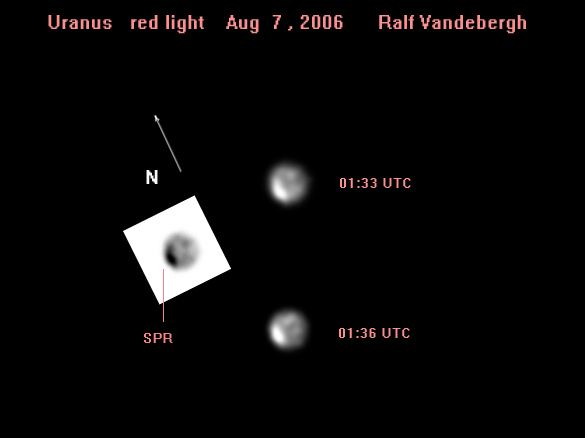 Here is an animation I made of HC-images from Aug 7
centered on the SPC(south polar region) of Uranus.Time difference of some minutes.
The exposure and contrast in these images is coordinated on the cap,so the rest of the planet is very
dark.This illustrates nicely the great albedo of the SPC.
Here is an animation I made of HC-images from Aug 7
centered on the SPC(south polar region) of Uranus.Time difference of some minutes.
The exposure and contrast in these images is coordinated on the cap,so the rest of the planet is very
dark.This illustrates nicely the great albedo of the SPC.
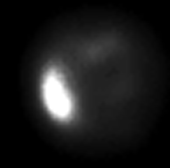 This set of additional processing from Aug 7 show some different interesting things.
The combined data from the red light images show the same dark albedo feature
on the North-pole as was visible in the lum-images(see first set sended).the lum images
don't show the SPR which is visible only in the red light,as presented here or I-band.
Added is also a sequence showing different levels of contrast.This presents how easy
the light of the SPC is scattered on the chip,due to our limited resolution by the Earths
atmosphere,but also how high its albedo is against the rest of the Uranian disk.
This set of additional processing from Aug 7 show some different interesting things.
The combined data from the red light images show the same dark albedo feature
on the North-pole as was visible in the lum-images(see first set sended).the lum images
don't show the SPR which is visible only in the red light,as presented here or I-band.
Added is also a sequence showing different levels of contrast.This presents how easy
the light of the SPC is scattered on the chip,due to our limited resolution by the Earths
atmosphere,but also how high its albedo is against the rest of the Uranian disk.
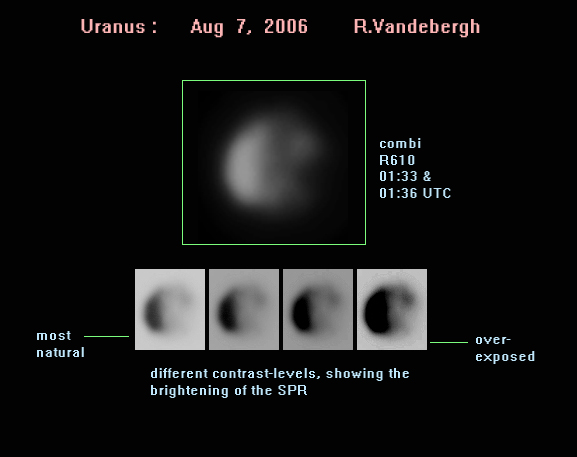 This might be interesting for the observers;
How compares a simulated unsharp Hubble image,(to create limited resolution) with an image of an amateur taken
in the red light?
Left: Hubble image from 2005,mid: simulated unsharpness from the same image,right: my own image from
Aug 7,2006.
We see incredible similarities,and different albedo features can be explained,also the dark appearance of the
North pole side of Uranus and a darker equatorial band.(it's more a contrast effect due to the bright SPR and
the dark disk).
The fact that the SPR looks still pretty large,while it is turning away more and more,can be explained by a combination
of poor resolution and scattering by the different high contrast effects.
This might be interesting for the observers;
How compares a simulated unsharp Hubble image,(to create limited resolution) with an image of an amateur taken
in the red light?
Left: Hubble image from 2005,mid: simulated unsharpness from the same image,right: my own image from
Aug 7,2006.
We see incredible similarities,and different albedo features can be explained,also the dark appearance of the
North pole side of Uranus and a darker equatorial band.(it's more a contrast effect due to the bright SPR and
the dark disk).
The fact that the SPR looks still pretty large,while it is turning away more and more,can be explained by a combination
of poor resolution and scattering by the different high contrast effects.
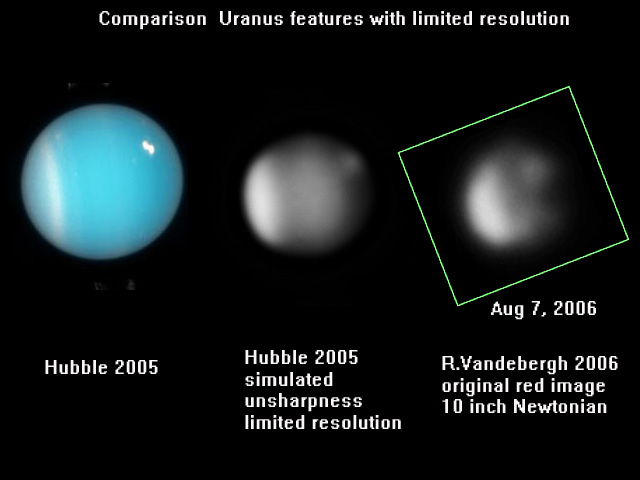 [バンディバ:オランダ]
[Ralf Vandebergh:Neighbourhood of Maastricht Netherlands]
[バンディバ:オランダ]
[Ralf Vandebergh:Neighbourhood of Maastricht Netherlands]
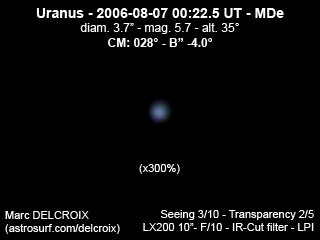
[Marc Delcroix Tournefeuille,France]


[Robert Heffner:Aichi,Japan]

Here are 2 other versions from my Aug 7 image of Uranus Especially limb darkening is obviously seen here. left: normal contrast,right:same filters but high contrast.
I observed Uranus on Aug 7.Images were taken using luminance,and through red and blue filters.This is my first session on the remote planet since October 2004. After processing of the first images,again some exitement came up,as there was clearly an albedo feature visible in the lum image,it manifests itself as a darkening on one site of the planet.This was not new for me,as I captured a compareable feature several times in 2004.The lum image from 01:42 UTC shows this darkening,as a kind of dark cap on one side of Uranus. Most important is that the control-image,taken 4 minutes later: 02:46 UTC shows the same feature.So this must be real. Added is also a high contrast version of this capture. On another interesting note is the appearance of the red images.Here is some albedo structure visible too,but we see totally other features.As the negative image illustrates best,the main feature on the red image is a brightening left on the disk.This must be the brightening of the south pole of Uranus,as this should be the most striking detail in red or IR images. As expected,the blue image(here taken unfortunately partially through the clouds,so not optimal circumstances)shows nearly no detail.A green image could not be taken,due to upcomming clouds,so the color result is RsGB. Here are the final processings of my Aug 7,Uranus session. The natural color version is composed of the data from the red image(with the brightening of the SPR)and the blue image. The High contrast bw version shows some other albedo variations too. Both images show the bright SPR,on the left side of the disk as the most striking albedo feature of Uranus.



Here is an animation I made of HC-images from Aug 7 centered on the SPC(south polar region) of Uranus.Time difference of some minutes. The exposure and contrast in these images is coordinated on the cap,so the rest of the planet is very dark.This illustrates nicely the great albedo of the SPC.
This set of additional processing from Aug 7 show some different interesting things. The combined data from the red light images show the same dark albedo feature on the North-pole as was visible in the lum-images(see first set sended).the lum images don't show the SPR which is visible only in the red light,as presented here or I-band. Added is also a sequence showing different levels of contrast.This presents how easy the light of the SPC is scattered on the chip,due to our limited resolution by the Earths atmosphere,but also how high its albedo is against the rest of the Uranian disk.
This might be interesting for the observers; How compares a simulated unsharp Hubble image,(to create limited resolution) with an image of an amateur taken in the red light? Left: Hubble image from 2005,mid: simulated unsharpness from the same image,right: my own image from Aug 7,2006. We see incredible similarities,and different albedo features can be explained,also the dark appearance of the North pole side of Uranus and a darker equatorial band.(it's more a contrast effect due to the bright SPR and the dark disk). The fact that the SPR looks still pretty large,while it is turning away more and more,can be explained by a combination of poor resolution and scattering by the different high contrast effects.
[バンディバ:オランダ] [Ralf Vandebergh:Neighbourhood of Maastricht Netherlands]

 ALPO-Japan Latest
ALPO-Japan Latest

 Uranus Section
Uranus Section